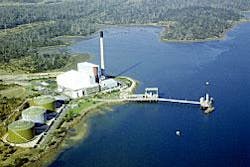Market Movement
FACTS: China's petroleum product import woes
Earlier excitement among international marketers over China's promise to open its market to more imports of lighter petroleum products besides fuel oil-as its price for membership in the World Trade Organization-is fading after a slow start and a fast shuffle by Chinese authorities, said a market analyst.
The result may be fewer imports of petroleum products into the Chinese market this year, said Fereidun Fesharaki, president and founder of Honolulu-based Fesharaki Associates Consulting & Technical Services Inc. (FACTS).
Obligations, delays
"China has two obligations related to imports of refined products under WTO: increasing the import quota each year by 15% and allocating 20% of the import quota to companies other than designated state oil companies," Fesharaki said.
At the time of its entry into WTO last December, China also promised to lift its "temporary" ban on imports of foreign gasoline and diesel, imposed in 1998 to protect its domestic refineries.
Instead, Fesharaki said, Chinese officials waited 4 months before finally issuing a detailed 2002 import quota for refined products at the end of April. Of the total 420,400 b/d of imported petroleum products authorized under this year's quota, 80% will be brought into China by four firms designated by a government commission as the official state oil trading companies-China National Chemical Import & Export Co. (Sinochem), United International Petroleum & Chemicals Co. Ltd. (Unipec), China National United Oil Co. (Chinaoil), and Zhuhai Zhenrong Co.
However, Fesharaki said, competition for the remaining 20%, or 85,000 b/d, also is open to "any other Chinese state and local oil company other than the four designated state oil trading companies." That includes other large Chinese firms such as state-owned China National Petroleum Corp. (CNPC), its PetroChina Co. Ltd. subsidiary, and China Petrochemical Corp. (Sinopec).
"Before all the details became available, the speculation was that the 85,000 b/d quota would be equally split between gasoline and diesel that was to be imported by foreign companies, which would have a significant impact on China's product trade. That did not happen," said Fesharaki in a May report. "It is clear now that the majority of the 85,000 b/d goes to fuel oil." (See table.)
The 2002 gasoline import is restricted to a "meager" 5,000 b/d, allocated entirely to the four designated state companies that also get 70% of the allotted 20,000 b/d of light diesel imports and all of the 18,000 b/d of waxy vacuum gas oil (VGO) and atmospheric gas oil (AGO), which are normally used as refinery feedstock in China.
Imports decline
With the late start and China's "unique definition" of state oil trading companies with the largest quota, imports of petroleum products into China may actually decrease this year, said Fesharaki, an economist specializing in oil and gas market analysis and the downstream petroleum sector with a special emphasis on the Asia-Pacific region.
Among the four designated state trading companies during the first quarter of this year, "gasoline imports were zero, and light diesel imports were only 4,000 b/d, lower than the 6,000 b/d imported during the first quarter of 2001 [and] far below their quotas," he said.
"If the past is any guide," said Fesharaki, the four companies "may or may not import gasoline and diesel to the fullest extent permitted by the quota, perhaps not even close"-especially if under government orders to protect Chinese refiners.
Because of its slow start, Fesharaki said, "China would have to import an average of over 25,000 b/d [of] light diesel-or a total of 50,000 b/d if waxy oil is included-and nearly 350,000 b/d of fuel oil [through] December to be able to use up the entire quota."
US still faces less supply, more demand for natural gas
Reports that weather-adjusted US demand for natural gas declined by 5-10 bcfd as prices recently climbed above $3.50/Mcf "don't pass the smell test," said a Houston-based financial analyst with a reputation for being bullish on that market.
J. Marshall Adkins, with Raymond James & Associates Inc. of St. Petersburg, Fla., claims such reports are based on "questionable data" about US gas storage and incorrect methodology of analysis.
"Many analysts are incorrectly using annual linear regression models to correlate shoulder month degree days with injections," he said. "Most are assuming that the weekly storage numbers [for the period in April when responsibility for reporting storage was transferred from the American Gas Association to the US Energy Information Administration] are correct."
At the time, several industry sources praised the smoothness of that transition. However, Adkins said, "We believe there was substantial confusion and even bad data generated by the process," including "2 weeks where the implied, weather-adjusted, year-over-year differential in natural gas supply and demand fell close to zero."
He said, "If we were to rely solely upon the two [near zero] points in late April, then one might in fact conclude that there had been meaningful demand deterioration." However, he noted, "The past 2 weeks have seen a return to the more believable [level] of 5 bcfd less natural gas in the system that was evident for the first 3 months of the year.
"In other words, we believe that the historical data support our thesis that there is at least 2 bcfd less natural gas supply in the system and 3 bcfd more natural gas demand than last year."
About 10 bcfd of US gas demand was lost during a 6-week period in January and February 2001 as gas prices soared toward $10/Mcf. But today's prices are "nowhere near" that level, Adkins said.
Moreover, he said, "The economy is on the upswing today, rather than the downswing as seen in early 2001. Many of the industrial consumers that were forced to shut down in 2001 are now scrambling to restock depleted product inventory levels." More importantly, he said, "The rise in oil prices has eliminated the incentive for fuel switching."
Adkins predicts that injections of gas into US storage will be reduced to a weekly average of 65-75 bcf over the next 6 weeks. "Then it should be more than evident to everyone that there has, in fact, been no demand deterioration and that US natural gas supply-demand is much tighter than it was during this time last year," he said."
Industry Scoreboard
null
null
Due to a holiday in the US, data for this week's Industry Scoreboard are not available.
Industry Trends
MERGER AND ACQUISITION activity within the oil service and supply sector will likely continue apace over the next 2 years. That word comes in a report from Houston-based Simmons & Co. International.
Over the last few years, M&A activity among oil service companies has led to the formation of a "big three" set of companies within the sector, Simmons said.
"We also believe that the pace of consolidation within the oil service industry, relative to the current level of M&A activity, will pick up as we begin another cyclical upswing for the energy industry," said Simmons, adding, "This is not the best way for companies to acquire 'cheaply,' but history shows that oil service companies are momentum buyers."
Product and asset companies, meanwhile, are continuing to merge as well, with product companies also heading toward a "big three" set of companies while asset firms remain relatively fragmented. Regarding asset firms, Simmons forecast there would be "the potential for meaningful consolidation" within the segment, "especially amongellipseoffshore and land drilling contractors."
Simmons said the "Rule of Three" specifies that "the optimum competitive landscape for an industry is comprised of three broad-line generalist companies and various, smaller niche companies." Currently, this "Big Three" dynamic is present within certain oil services segments, including pressure pumping, wireline logging, drilling fluids, electric submersible pumps, and measurement-while-drilling services. Other segments, meanwhile, remain fragmented, including companies handling land rigs, offshore rigs, and supply boats.
The oil service industry has experienced hundreds of M&A transactions over the past 10 years, Simmons said (see table). The frequency of these transactions tends to follow the industry cycle.
"The number of major transactions reaches its apex at industry cycle peaks, and the corollary similarly holds true, i.e., the number of transactions bottoms at industry cyclical troughs," the firm said.
"For example, from 1996 through 1998, a period of strong industry fundamentals, the number of transactions was considerably greater than in the 3 years preceding this period. Similarly, as industry fundamentals improved meaningfully in 2000 and 2001, there was a significant increase in the number of deals during this period compared to that in 1999," Simmons said.
Government Developments
US SENATE Majority Leader Tom Daschle (D-SD) has asked President George W. Bush to nominate Suedeen Kelly (D-NM) to fill an upcoming vacancy on the Federal Energy Regulatory Commission.
Congressional sources predicted the White House would honor Daschle's request.
If confirmed by the Senate, Kelly would replace Linda Key Breathitt, a former Kentucky utility regulator whose 5-year term expires this year. Breathitt was interested in serving another term, but Kelly has stronger congressional support, most notably from Senate Energy and Natural Resources Chairman Jeff Bingaman (D-NM).
Kelly was chairwoman of the New Mexico Public Utilities Commission during 1984-86. As a law professor at the University of New Mexico, the Albuquerque resident teaches public utility regulation, energy law, legislative process, and administrative practice.
FERC is composed of five members who are appointed by the president. No more than three members may belong to the same political party.
Republican Pat Wood III, a former state energy regulator from Texas, now serves as FERC's chairman. One other Republican, Nora Mead Brownell, is a commissioner. A third Republican, Joseph Kelliher, a political appointee to the Department of Energy and former congressional staff member of the House Energy and Commerce Committee, is expected to complete the remaining Republican vacancy that occurred when Curtis Hebert left the agency (OGJ, Aug. 20, 2001, p. 7).
William Massey will be the sole Democrat on the commission as of June 30, unless Kelly is confirmed by then.
INTERNATIONALLY, prospects appear to be improving for a resolution to the Caspian Sea boundary dispute.
US officials and foreign policy analysts said May 23 that the odds are getting better that industry soon will see a satisfactory resolution to a decades-old border dispute between Azerbaijan and Iran over Caspian Sea boundaries.
"The failure to break the deadlock over the Caspian's legal status threatens to hamper oil exploration and heightens instability in the already volatile region," said the Eurasia Group, a foreign policy think tank.
Eurasia Group noted that of the five Caspian Sea littoral states, Iran and Azerbaijan are the furthest from agreement on how to divide the Caspian for oil development purposes.
An April summit again failed to yield a regional consensus, and since then individual countries have made their own deals with each other; the most recent was between Russia and Kazakhstan (OGJ Online, May 15, 2002).
An historic 3-day summit between the presidents of Iran and Azerbaijan in Tehran did not yield a formal resolution to their border dispute. Nevertheless, the two leaders are encouraging informal discussions on joint development of disputed oil fields, said US officials and Caspian diplomats.
An Iranian delegation is expected to visit Baku in late July, with diplomats anticipating that a bilateral agreement can be reached before September. Industry meanwhile is hopeful the two countries can strike a deal to jointly explore and develop the Araz-Alov-Sharg prospects, now claimed by both countries.
Quick Takes
A CONSORTIUM including units of Calgary-based Talisman Energy Inc., Malaysia's Petronas Carigali Sdn. Bhd., and Hanoi-based Viet Nam Oil & Gas Corp. (Petrovietnam) has been awarded Block 46/02 off Viet Nam.
Talisman Vietnam Ltd. and Petronas Carigali Overseas Sdn. Bhd. each have a 30% stake in the consortium, while Petrovietnam Exploration & Production has 40%.
The Viet Nam government has yet to approve the award, which also remains subject to the finalization of a petroleum contract and joint operating arrangement.
Talisman Pres. and CEO Jim Buckee said, "Block 46/02 is located adjacentellipseour ongoing development in the Malaysia-Viet Nam PM-3 Commercial Arrangement Area (PM-3 CAA) and is interpreted to contain an extension to the PM-3 CAA play. The block offers the potential for a number of small field discoveries, which quickly and economically can be tied back to the PM-3 CAA facilities."
Block 46/02 covers 3 million acres and is 100 miles off the southern coast of Viet Nam in 120-150 ft of water. A number of oil and gas discoveries, made by the previous operator of the block, flowed at rates as high as 5,500 b/d of oil and 26 MMcfd of low-carbon dioxide content natural gas, Talisman said.
The consortium's commitment on Block 46/02 includes conducting a 3D seismic survey and drilling four wells during a 3-year exploration phase.
Elsewhere on the exploration front, Indonesian state oil firm Pertamina discovered 1.07 tcf of natural gas reserves with its latest appraisal well on the Senoro-Toili Block in central Sulawesi, the Indonesian province between Borneo and the Lesser Sunda islands, raising its estimate of gas reserves on the block to 4 tcf. On test, the Senoro No. 3 well flowed 12 MMscd of natural gas and 237 b/d of condensate. Pertamina and Indonesia's PT Exspan Tomori Sulawesi are exploring the block under a joint operating contract involving previously explored areas. Additional appraisal drilling is planned for August, Pertamina said. Last year, PT Exspan Tomori Sulawesi completed Senoro No. 2 well, which flowed 20 MMcfd of gas and 435 b/d of condensate, Pertamina said (OGJ Online, July 26, 2001).
Coastal Petroleum Co., Apalachicola, Fla., has sued Florida alleging that the state is taking the company's property without compensation by denying it a drilling permit in the Gulf of Mexico. The lawsuit concerning Lease 224-B follows a similar suit filed in January 2001 regarding Lease 224-A (OGJ, Feb. 5, 2001, p. 46). The two leases are adjoining. The latest lawsuit, filed in Leon County Circuit Court, asks the court to determine the fair market value of the 1947 state lease that gives Coastal Petroleum the exclusive right to drill for oil and gas in state waters in the gulf. Lease 224-B covers 400,000 acres extending offshore from Pasco County to Collier County.
Nexen Inc., Calgary, and Shell Exploration & Production Co. (Sepco), New Orleans, have agreed to jointly explore a 1,044 sq mile area of the US Gulf of Mexico for natural gas in Miocene reservoirs. The agreement's focus of mutual interest covers 116 blocks in the Ship Shoal and South Timbalier areas. Within these areas, Nexen has the right to earn 40% interest, and Sepco has the right to earn 60% interest in any acreage acquired. The first well to be drilled will be a test of the Fergana prospect on South Timbalier 239 and 248 blocks, 115 miles south of New Orleans in 210 ft of water. Drilling is expected to start in late May, and the well is expected to reach 22,500 ft TD in 140 days.
CANADIAN IMPERIAL VENTURE CORP., St. John's, Newf., has completed the commissioning of existing facilities and was granted all necessary approvals and permits to begin production of oil and natural gas from its Garden Hill field in western Newfoundland, company officials said.
The production lease, which the government of Newfoundland and Labrador issued in late April, was the first ever for onshore operations in that province. The lease covers 33,000 acres along a prospective fault-bounded inversion fairway on the Port au Port Peninsula and includes the Port au Port No. 1 discovery well.
The initial term of the lease is 10 years, but it can be extended for one or more 5-year terms.
Recent well testing during the commissioning and hookup phase indicated that additional recompletion of the discovery well would improve production. Canadian Imperial Venture performed the engineering and contracted Schlumberger Ltd. for the recompletion.
In other producction happenings, Teton Petroleum Co., Steamboat Springs, Colo., announced that its field production in western Siberia has increased to 4,080 b/d of oil, with 1,020 b/d net to Teton. Teton has produced oil from Egurayk field since 1997. The company recently completed Well No. 600, which is flowing 730 b/d of oil. Teton anticipates more production with the completion of three more wells expected within another month. Teton recently began pumping oil through its 40 km pipeline, enabling production year-round from the Eguryak license, 20 miles north of supergiant Samotlor oil field. The company conducts its active business solely through a 50% ownership interest in Goltech Petroleum LLC, a Texas limited liability company. Goltech operates through ownership of a 70.59% interest in Goloil, a Russian joint stock company.
REEF INTERNATIONAL LLC, a subsidiary of Tidelands Oil & Gas Corp., Corpus Christi, Tex., has commenced its permitting process to obtain state, federal, and international permits for a large-diameter, natural gas pipeline crossing from El Paso, Tex., to Juarez, Mexico. The exact diameter was not specified.
Reef International has contracted BNC Engin- eering Services, Austin, to perform the engineering and design work on the pipeline.
Meanwhile, Reef International also said that permitting process is nearing completion for a pipeline to deliver natural gas, propane, and butane into Mexico. That line would run from Eagle Pass, Tex., to Piedras Negras, Mexico (OGJ Online, Sept. 5, 2001).
Pending final permits, construction of the Eagle Pass-Piedras Negras project could start as soon as July 1, a Tidelands spokesman told OGJ.
In other pipeline news, Horizon Pipeline Co., Houston, has put into service its new $80 million natural gas pipeline in northern Illinois. Construction began in November 2001 on gas compression facilities in Joliet, Ill., and 28 miles of 36-in. pipeline. The line connects to an existing 46 mile system leased from Houston-based Natural Gas Pipeline Co. of America (NGPL). The new 380 MMcfd capacity system connects the supply hub at Joliet with the northern part of the Nicor Gas distribution system and NGPL's pipeline system. Horizon Pipeline is a joint venture of Nicor-Horizon-a subsidiary of Nicor Inc., Naperville, Ill.-and NGPL, a subsidiary of Kinder Morgan Inc., Houston. El Paso Corp., Houston, has announced new open seasons through June 12 for its proposed Seafarer natural gas pipeline system, which will transport natural gas from the Bahamas to southern Florida.
The 162 mile, 26-in. system-formerly called Bahama Cay pipeline-will transport 1 bcfd of gas from the planned El Paso Global LNG terminal at Grand Bahama Island to West Palm Bach, Fla. (OGJ, Apr. 1, 2002, p. 9). Preliminary open seasons were conducted in October 2001, but new open seasons are being held because the project's capacity and scope were expanded from 750 MMcfd to 1 bcfd, El Paso said. The pipeline project will comprise two line sections, one to either side of the boundary of the US Exclu- sive Economic Zone in the Atlantic Ocean. The first section, to be built and owned by a unit of El Paso, will extend 88 miles from the Grand Bahama Island LNG terminal to the international boundary. Another El Paso unit will develop and operate the remaining 75 mile section, which will connect to the Florida Gas Transmission pipeline system. The Seafarer pipeline system is slated to come on line by the second quarter of 2005.
Canadian Superior Energy Inc., Calgary, and El Paso Oil & Gas Canada Inc., an indirect subsidiary of El Paso Corp., contracted for the Rowan Gorilla V, owned and operated by Rowan Cos. Inc., Houston, to drill the first well on the Marquis natural gas prospect off Nova Scotia, officials said.
Canadian Superior is one of the largest acreage holders off Nova Scotia, with 100% interest in 934,065 acres. It recently formed a joint venture with El Paso to explore its holdings in the shallow waters of the Scotian shelf.
Terms of the joint venture were not disclosed (OGJ Online, May 1, 2002).
The first Marquis well is to be drilled to at least 4,300 m TVD, or whatever it takes to test sufficiently the main deep Abenaki reef section, officials said.
The prospect is located 20 km northwest of Sable Island and is directly on trend with and analogous to the recent Deep Panuke Abenaki reef natural gas discovery 25 km to the southwest.
Several delineation wells in the Deep Panuke find have been successfully tested, each with productive capacity in excess of 50 MMcfd when brought on line, officials said.
Completed in November 1998, the Rowan Gorilla V features a derrick with a total combined drilling capacity of 3.5 million lb, 16,975 hp prime mover capacity, 8,800 hp mud pump capacity, and a total drilling load capacity of 16.25 million lb.
Canadian Superior acquired its Marquis exploration licenses in October 2000 for work expenditure bids of $27.7 million (Can.).
The prospect consists of two exploration licenses covering about 110,000 acres 160 km off Nova Scotia.
Unocal Corp. said its subsidiaries have filed a declaration of commercial discovery with Petrovietnam in order to proceed with the development of three natural gas fields off southwestern Viet Nam.
The declaration follows 10 successful exploration wells drilled on Blocks B and 52/97, including 4 wells drilled last year. Unocal plans to develop the three fields in a single program using shared facilities.
The declaration covers resources that have been discovered in Kim Long, Ac Quy, and Ca Voi natural gas fields. Based on the drilling to date, Unocal believes the fields have a combined gross discovery volume of 2.5 tcf.
In its latest exploration and appraisal drilling program off Viet Nam, Unocal drilled four wells. The B-KL-4X well on Kim Long prospect found 300 ft of net gas pay, the thickest among the four wells drilled on Kim Long so far.
The 52/97-CV-3X well extended Ca Voi field; it found 151 ft of net gas pay and flowed on test 37 MMcfd from four zones.
Two appraisal wells extended Ac Quy field-the 52/97-AQ-4X well found 117 ft of net gas pay and flowed 48 MMcfd from four zones, while the 52/97-AQ-5X well found 301 ft of gas pay.
Unocal and its partners have production-sharing contracts with Petrovietnam covering Blocks B, 48/95 and 52/97 off southwestern Viet Nam. Unocal subsidiaries serve as operator for all three PSC areas.
Power station conversion supports Tasmanian gas project
The conversion of Hydro Tasmania's Bell Bay power station from oil-fired to natural gas operation is a key factor in the $400 million (Aus.) Tasmanian gas project to be put into operation this year. The project involves bringing gas to Tasmania via a new 753 km, 350-mm subsea and underground pipeline from Longford, Vict.
A unit of Duke Energy Corp., Charlotte, NC, is constructing the pipeline and carrying out the station conversion. Of the two boiler-turbine units at the station, only Unit 1 is undergoing conversion, while Unit 2 remains available for emergency use in its original oil-fired configuration.
In Stage 2, gas pipelines will be constructed from Bell Bay south to a junction point near Rosevale and then 240 km west to Port Latta, and in Stage 3, from the junction point south to Hobart.
Esso Australia Resources Pty. Ltd. and a unit of BHP Billiton Ltd. will supply the gas to Tasmania, via the pipeline, for 15 years. Deliveries from Esso-BHP's Bass Strait fields to the Longford gas processing plant are expected to begin this year.





